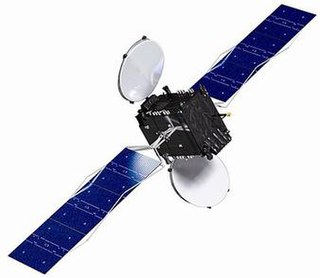Loading AI tools
Family of spacecraft buses From Wikipedia, the free encyclopedia
Star Bus is a satellite bus family of Orbital ATK. It was originally developed by Thomas van der Heyden, co-founder of CTAI, and later sold to and manufactured by Orbital Sciences Corporation.[citation needed]
This article only references primary sources. (October 2024) |

The Star Bus satellite platform is designed for various applications, including communications, remote sensing, and scientific missions. The highly configurable platform allows customization to meet specific mission requirements. In addition, it can support a wide range of payloads, including high-resolution imaging systems, microwave sensors, and advanced communication systems.
The Star Bus platform is designed with a modular architecture, allowing for easy integration of various subsystems and payloads. The bus provides power, communications, and data handling capabilities, while the loads provide mission-specific capabilities. The platform is designed to be highly reliable and has been used in various missions, including the Hubble Space Telescope and NASA's New Horizons mission to Pluto.
Since its initial development, the Star Bus platform has undergone continuous enhancements, expanding its capabilities for increasingly complex missions. Orbital ATK, now part of Northrop Grumman after its acquisition in 2018, has further refined the platform to support geostationary communications satellites, low Earth orbit (LEO) missions, and interplanetary exploration. These advancements include improvements in power generation, thermal management, and propulsion systems, making it one of the most versatile satellite platforms in the industry. The Star Bus family has been employed in both commercial and governmental projects, including the SES and Intelsat communications constellations.[1][non-primary source needed]
The first satellite program based on the Star Bus platform, developed by Thomas van der Heyden for the Indonesian Direct Broadcast program IndoVision, was IndoStar-1, which was launched in November 1997.[citation needed]
This section needs expansion. You can help by adding to it. (February 2011) |
| Name | Mission type | Orbit | Payload capability | Mission life | |||
|---|---|---|---|---|---|---|---|
| RapidStar-1 | Military/Reconnaissance | LEO | 60 kg/75W | 1–5 years | |||
| RapidStar-2 | Military/Reconnaissance | LEO | 200 kg/500W | 1–5 years | |||
| LEOStar-2 | Civil/Military | LEO | 150 kg/400W | 1–10 years | |||
| LEOStar-3[2] | Civil/Military | LEO | 3,000 kg/800W | 1–10 years | |||
| GEOStar-1 | Military/Reconnaissance | GEO | 150 kg/200W | 5–7 years | |||
| GEOStar-2 | Communications | GEO | 500 kg/5.5 kW | 15–18 years | |||
| GEOStar-3 | Communications | GEO | 800 kg/8.0 kW | 15–18 years | |||
| MicroStar-1 | Constellation | LEO | 15 kg/360W | 1–3 years | |||
| ESPAStar-1 | Military/Reconnaissance | LEO or GEO | 250 kg/500W | 1–5 years | |||
| ESPAStar-2 | Military/Reconnaissance | LEO or GEO | 1,080 kg/1.2 kW | 1–5 years | |||
| References: [3] | |||||||
Seamless Wikipedia browsing. On steroids.
Every time you click a link to Wikipedia, Wiktionary or Wikiquote in your browser's search results, it will show the modern Wikiwand interface.
Wikiwand extension is a five stars, simple, with minimum permission required to keep your browsing private, safe and transparent.